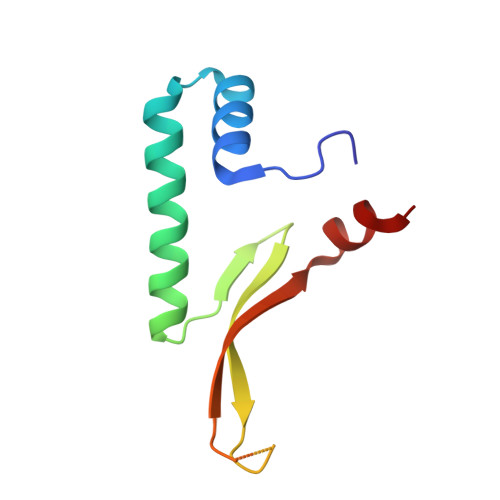HU histone-like DNA-binding protein from Thermus thermophilus: structural and evolutionary analyses.
Papageorgiou, A.C., Adam, P.S., Stavros, P., Nounesis, G., Meijers, R., Petratos, K., Vorgias, C.E.(2016) Extremophiles 20: 695-709
- PubMed: 27342116
- DOI: https://doi.org/10.1007/s00792-016-0859-1
- Primary Citation of Related Structures:
5EKA - PubMed Abstract:
The histone-like DNA-binding proteins (HU) serve as model molecules for protein thermostability studies, as they function in different bacteria that grow in a wide range of temperatures and show sequence diversity under a common fold. In this work, we report the cloning of the hutth gene from Thermus thermophilus, the purification and crystallization of the recombinant HUTth protein, as well as its X-ray structure determination at 1.7 Å. Detailed structural and thermodynamic analyses were performed towards the understanding of the thermostability mechanism. The interaction of HUTth protein with plasmid DNA in solution has been determined for the first time with MST. Sequence conservation of an exclusively thermophilic order like Thermales, when compared to a predominantly mesophilic order (Deinococcales), should be subject, to some extent, to thermostability-related evolutionary pressure. This hypothesis was used to guide our bioinformatics and evolutionary studies. We discuss the impact of thermostability adaptation on the structure of HU proteins, based on the detailed evolutionary analysis of the Deinococcus-Thermus phylum, where HUTth belongs. Furthermore, we propose a novel method of engineering thermostable proteins, by combining consensus-based design with ancestral sequence reconstruction. Finally, through the structure of HUTth, we are able to examine the validity of these predictions. Our approach represents a significant advancement, as it explores for the first time the potential of ancestral sequence reconstruction in the divergence between a thermophilic and a mainly mesophilic taxon, combined with consensus-based engineering.
- Section of Biochemistry and Molecular Biology, Department of Biology, National and Kapodistrian University of Athens, Panepistimiopolis, 15701, Athens, Greece.
Organizational Affiliation:

















